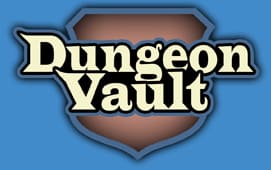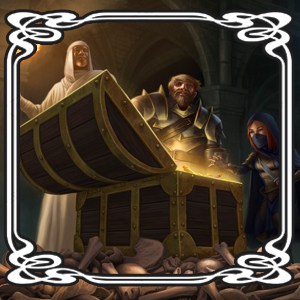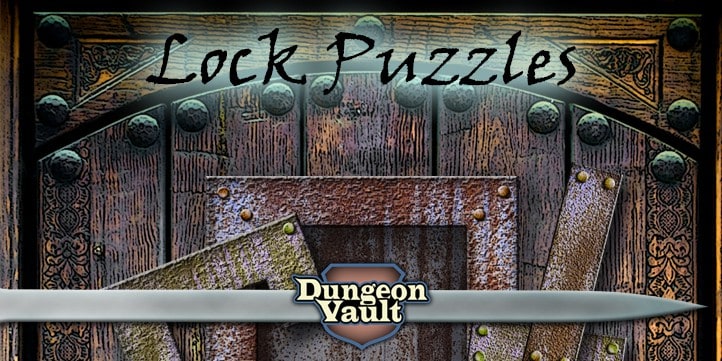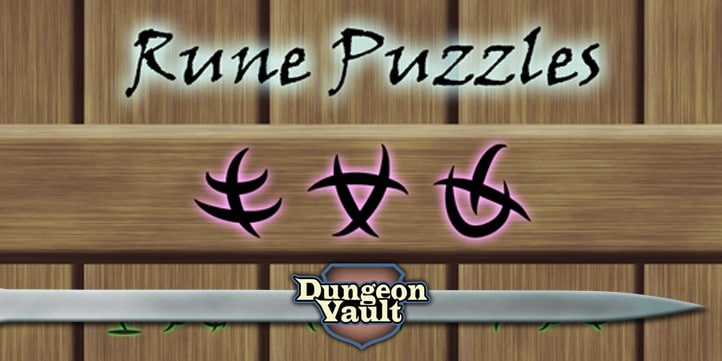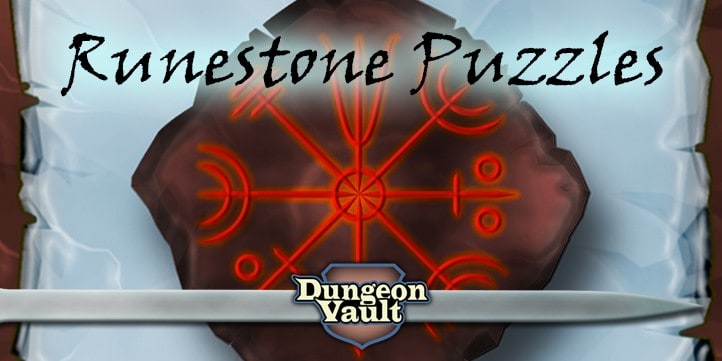
Chest puzzles are one of my favourite puzzles to put into a Dungeons & Dragons game. I mean, a big part of the reason players enter the dungeons and face the dragons is because of the treasure chests hold at the end of it. And what better way to secure that treasure than by placing a puzzle on the chest that locks it from looting adventurers?
In this article I’ll show you a bunch of different puzzles you can use to lock chests. But that’s not all. If you combine these puzzles, you can change a lowly chest into a complex puzzle box that will take players hours to solve. And anything that requires that much protective sealing must be valuable, right? That pandora story is just a myth!
If you’re looking for D&D puzzle boxes specifically, scroll to the second half of this article.
Now let’s get to it.
Sealing chests with puzzles in D&D
The first design I’d like to share are my 5 free door puzzles, which can be easily adapted to seal chests instead. You can download this puzzle here, and once you have, simply write rewrite the puzzle onto an image of a chest (or stick it on a real one) and you’re done.


What I love about this puzzle is that it is so fast. You literally only need to write two words and highlight some letters and you are ready to go. Great for sealing chests, but really, any DM should have a couple of these in their back pocket to drop onto items they wish to seal at a moment’s notice.
Sealing chests with lock puzzles
The first puzzle is magical in nature. But chests are mainly hard wood and iron bands. And having a puzzle that reflects that vibe – and is more mechanical in nature – might fit your theme better.
With lock puzzles you can place up to nine basic locks onto a chest. Each lock consists of three key puzzle pieces and is easy to solve. But if you combine any number of these puzzles, they become increasingly difficult to solve. The more locks you add to the chest, the harder i becomes to open.
Now here’s the really cool part: There are over 500 ways to set up this puzzle. So your player will never encounter the same puzzle setup for your chest or puzzle box twice.
This puzzle has lots of metal puzzle pieces the players must collect. And, just like with the last puzzle, you can place these anywhere you like. (I like to stick them onto iron golems but that’s just me).
Sealing chests with rune puzzles
Rune puzzles are a little bit more complex. Like the first puzzle, they can be placed onto a chest or box. But with this puzzle, the players must also find the runes before they can translate them. And that offers a lot of DMing opportunities. For instance, if you wish for your players to explore the whole dungeon you could place these runes in different rooms. Or they might be found in any other place you wish your players to go.
There are 30 rune puzzles in the pack and while the first puzzles only need a couple of runes to unseal, the final puzzles require more runes. So this puzzle can be an ongoing theme where higher level treasure chests are sealed with puzzles that require more runes to solve.
If you combine this with the first puzzle, you can create yourself a D&D puzzle box. But more on that later.
Sealing chests with runestone puzzles
With runestone puzzles players must place stones upon the chest in a very specific pattern to unlock it. The nice thing is that this can be both a magical or a mechanical puzzle depending upon your preference.
- If the puzzle is magical than placing the runestones correctly unleashes the magic that opens the chest.
- If the puzzle is mechanical, than dwarfs have imbued these runestones with magnets that create just the right magnetic field to open the chest when placed correctly.
Runestone puzzles is more than just a puzzle pack. You can create an infinite amount of puzzles for your games with this system. Creating a puzzle takes minutes.
Creating a D&D Puzzle Box
While chests with puzzles on them are fine, a puzzle box is a whole different category. Puzzle boxes contain multiple puzzles that are layered on top of each other. Players solve one puzzle, only to be confronted with the next. Here are my tips for creating your own puzzle box and for running it effectively.
The simplest way to create a puzzle box is by placing chests into bigger chests like nesting dolls. If players open the outer most chest, they gain access to the next chest and the puzzle pieces needed to open it. So you might start with the free puzzle I mentioned, move to the rune puzzle for the next chest, then use the lock puzzle for chest number three, and so on. If you use cardboard boxes of different sizes for your puzzle box, that’s even better. Players love actual objects at the table.

While you can make a perfectly great puzzle box this way, it can feel linear to players. You can add complexity by placing two puzzles onto a box that both need to be solved in order to open it. Or you can place two boxes inside a larger box that each have their own puzzle.
Another way I like to add complexity is stashing puzzle pieces and clues inside the first box that can only be used with the third of fourth box. This way, players open the first box and get a ton of puzzle pieces and clues. But only some are relevant for opening the second box. And once they’ve open the second box and find the third box, the function of the pieces they found in the first one start to make sense. It’s still a linear puzzle box setup, but it doesn’t feel that way.
Other tricks are having a double floor in a box or writing clues on the outside of a box that are so obvious players tend to overlook them. And don’t be afraid to mix it up. Maybe players open a box and a ghost appears who asks a riddle. Or a box turns into a mimic for three rounds every time players give the wrong answer to a puzzle. Variety is the spice of life.
Layering puzzles can be done with puzzle boxes but the principles are the same as laying out puzzles in a dungeon. Instead of rooms, we use boxes or chests but they are both just closed off spaces that can contain something. So if you’re having trouble visualising how to layer puzzle for your D&D game, take a look at the ‘layering D&D door puzzles’ section of this article.
Running a better D&D puzzle box campaign
Now that we’ve looked at how to build puzzle boxes, let’s explore how to best run them in your D&D game.
The natural tendency for most DMs is probably to want to run a whole puzzle box in a single D&D session. But I would advise against that. Most players do not enjoy working 2 to 4 hours puzzling away at a single puzzle box.
Instead, consider having players take the puzzle box with them on their adventures and allow them to further solve pieces of it as the story progresses. So they might find an ancient rune at a location which allows them to solve a piece of the puzzle box in their downtime. And in the next session they find the iron keys that help solve the next layer of the box. This way, solving the puzzle box stays relevant throughout your campaign and your players can explore the puzzle when they feel like it.
And each time they unlock another layer, they could find an engraving giving a crucial piece of information relating to the main plot. What if the engraving read: ‘The key lies with King Trodan’. That might lead to a little royal tomb raiding. Or a treasure map might lead to a pirate hideout where the next key lies.
Instead of having just one puzzle session that takes forever, opening the puzzle box becomes an intrical part of the story. Or course, you will still need a ton of puzzles to pull this off. Luckily we have the world’s largest collection of puzzles for D&D and other roleplaying games right here!
If you’re interested, check out the Vault Bundle. It all the puzzles you need for a lifetime of DMing.
By Paul Camp
Image credit: Magic the Gathering, Dungeonvault
